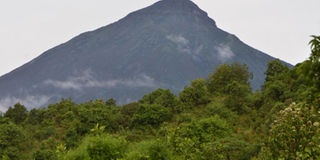Mgahinga park: The epitome of beauty

Muhabura, the highest of the three peaks in Kigezi. Locals originally looked to it for directions thus the name Muhabura loosely translated as guide. Photo by Matthias Mugisha
Imagine being in three countries simultaneously. One leg in the DR Congo another in Rwanda and your face and arms in Uganda. Imagine you delivered a baby at the intersection lines, surrounded by the best views in Africa. What would be the nationality of such a baby?
I would love to see an adventurous pregnant woman try delivering a baby in Mgahinga Gorilla National Park. If the baby is a boy, name it Matthias Mugisha or the Saturday Monitor.
Mgahinga Gorilla National Park sits between 2,227m and 4,127m above sea level in the south western Uganda district of Kisoro. It is part of the much larger Virunga Conservation Area which includes adjacent parks in Rwanda and the DR Congo.
Busting with wildlife
The 34sqkm park is home to 39 mammal species, including the mountain gorilla (gorilla beringei), elephant and buffalo. There is also the rare golden monkey said to be found only in the Virungas and two other forests in Central Africa.
Blue monkeys also call the park home just like the spotted hyena, the golden cat, leopard, serval cat, side-striped jackal, giant forest hog, black-fronted duiker and bushbuck, among other mammal species.
The park also has 79 bird species so far recorded with several endemics and is an important water catchment in the area.
Mgahinga Gorilla National Park, with one habituated trans-boundary gorilla group, was declared a game sanctuary in 1930 and was finally gazetted as a national park in 1991 to protect the endangered mountain gorilla.
It is the only park with oversized mountain gorillas. This family of habituated gorillas does not recognise the political boundary between Uganda and Rwanda.
The gorilla beringei is one of the two subspecies of the eastern gorilla made up of two populations. One is found in the Virunga volcanic mountains within Mgahinga, in north west Rwanda and in the eastern DR Congo. The other is found in Uganda’s Bwindi Impenetrable National Park.
Home to the gorilla
Some primatologists consider the Bwindi population in Uganda to be a separate subspecies though no authoritative studies have been completed.
By observation, the gorillas in Mgahinga are much larger than those of Bwindi Impenetrable National Park. There are around 880 mountain gorillas in the world with half of them are found in the misty Bwindi.
The International Union for Conservation of Nature (IUCN) lists the Gorilla beringei species (mountain gorillas and Eastern lowland gorillas) as endangered on its Red List of Threatened Species.
Mgahinga was formerly inhabited by indigenous pygmies “Batwa” and is still of great cultural significance to them. At the centre of the Batwa’s attachment to the park is Garama Cave.
The cave used to be a palace for an unnamed Twa king. Another version is that the cave was used as a shelter during battles and as a store for war spoils. The cave can be visited during the Batwa trail walk, one of the main tourist activities in the park. The Batwa, whose population is on the decline, perform war songs for tourists around the cave.
The land of three peaks
The most striking features of the park are its three conical, extinct volcanoes that form part of the scenic Virunga Range that lies along the border region of Uganda, the DR Congo and Rwanda.
The highest of the three peaks is Muhabura (4,127m). Muhabura, commonly known as Muhavura means a guide. The locals used to look for its high peak to help them get a sense of direction. The cone shaped Muhabura has a crater on top.
The second is Sabyinyo at 3,645 m. Sabinyo is the only peak most probably in the world that is located in three countries. The summit of the mountain marks the intersection of the borders of the DR Congo, Rwanda, and Uganda.
A child born at the peak will most probably have three nationalities. Should you want to be in three countries at the same time, just climb Mt Sabinyo. And should you want to give birth to a child with three nationalities, just do the hard job and climb to the peak of Mt Sabinyo.
The smallest of the peaks Gahinga at 3,474m is named after small piles of volcanic debris usually found neatly piled up in gardens around. Mt Gahinga has a swamp-filled crater at the top.
The main activities in the park include gorilla tracking, birding, mountain climbing and nature walks. The park commands one of the most spectacular views in Africa, especially at the summit of its mountains.
Kigezi, the sub-region in which the park is found, is usually referred to as the Switzerland of Africa. The sub-region is famous for its terraced hills, meandering roads and sky blue water lakes.
The local people -Bafumbira and Bakiga, are known to be one of the most hardworking tribes in the country. On the way to the park, the scenic views start along the way from Kabale. A trip to the scenic Lake Bunyonyi along the way is rewarding.
Deep Bunyonyi
Lake Bunyonyi is decorated with at least 20 small islands encircled by steep terraced hills. The most famous of the Islands is Akampene where in the olden days, girls who became pregnant before marriage were abandoned to die of starvation though none actually died. Men who would be short of bride price would rescue them and marry them.
Another is Kyahugye Island which is home to wildlife such as zebras and antelopes that were recently translocated there from Lake Mburo National Park. Located at 1,962metres above sea level and measuring about 25kms long and 7kms, Lake Bunyonyi is thought to be Africa’s second deepest water body.




